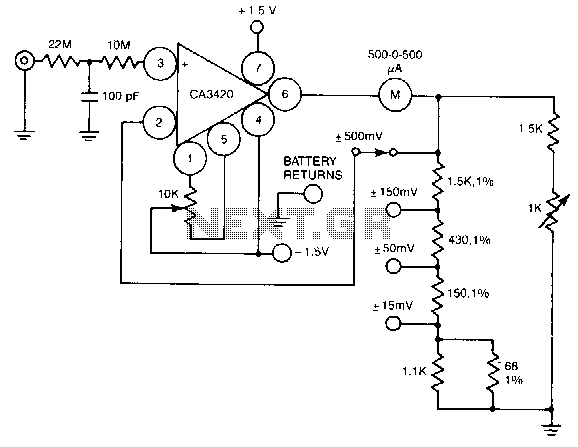
High-input-resistance-voltmeter

A resistance of 1,000,000 MΩ takes advantage of the high input impedance of the CA3420 BiMOS op-amp. Only two 1.5-V AA-type penlite batteries are required for use. Full-scale deflection is ±500 nV, ±150 mV, and ±15 mV.
The circuit utilizes a CA3420 BiMOS operational amplifier, which is characterized by its high input impedance, making it suitable for applications requiring minimal loading on the sensor or source. The selected resistance value of 1,000,000 MΩ (1 GΩ) serves to ensure that the input current remains extremely low, thereby preserving the integrity of the signal being measured or amplified.
Powering the circuit requires only two 1.5-V AA batteries, which provide a compact and efficient power source. The use of dual batteries allows for a total supply voltage of 3 V, suitable for low-power applications, and ensures extended operational life due to the low current demands of the op-amp.
The full-scale deflection specifications indicate the output voltage range that the circuit can handle effectively: ±500 nV, ±150 mV, and ±15 mV. This range suggests that the circuit is designed for precision measurements across a variety of scales, from very low signals (nanovolt range) to more substantial voltages (millivolt range). This versatility makes it ideal for applications in instrumentation, sensor interfacing, and other scenarios where accurate voltage readings are critical.
In summary, the combination of the CA3420 op-amp's high input impedance, the high resistance value, and the efficient power supply configuration renders this circuit suitable for precise voltage measurement tasks across a wide range of applications.A resistance of 1, 000.000 MD takes advantage of the high input impedance of the CA3420 BiMOS op amp. Only two 1.5-V AA-type penlite batteries are required for use. Full-scale deflection is ±500 niV, ±150 mV, and ±15 mV. 🔗 External reference
The circuit utilizes a CA3420 BiMOS operational amplifier, which is characterized by its high input impedance, making it suitable for applications requiring minimal loading on the sensor or source. The selected resistance value of 1,000,000 MΩ (1 GΩ) serves to ensure that the input current remains extremely low, thereby preserving the integrity of the signal being measured or amplified.
Powering the circuit requires only two 1.5-V AA batteries, which provide a compact and efficient power source. The use of dual batteries allows for a total supply voltage of 3 V, suitable for low-power applications, and ensures extended operational life due to the low current demands of the op-amp.
The full-scale deflection specifications indicate the output voltage range that the circuit can handle effectively: ±500 nV, ±150 mV, and ±15 mV. This range suggests that the circuit is designed for precision measurements across a variety of scales, from very low signals (nanovolt range) to more substantial voltages (millivolt range). This versatility makes it ideal for applications in instrumentation, sensor interfacing, and other scenarios where accurate voltage readings are critical.
In summary, the combination of the CA3420 op-amp's high input impedance, the high resistance value, and the efficient power supply configuration renders this circuit suitable for precise voltage measurement tasks across a wide range of applications.A resistance of 1, 000.000 MD takes advantage of the high input impedance of the CA3420 BiMOS op amp. Only two 1.5-V AA-type penlite batteries are required for use. Full-scale deflection is ±500 niV, ±150 mV, and ±15 mV. 🔗 External reference